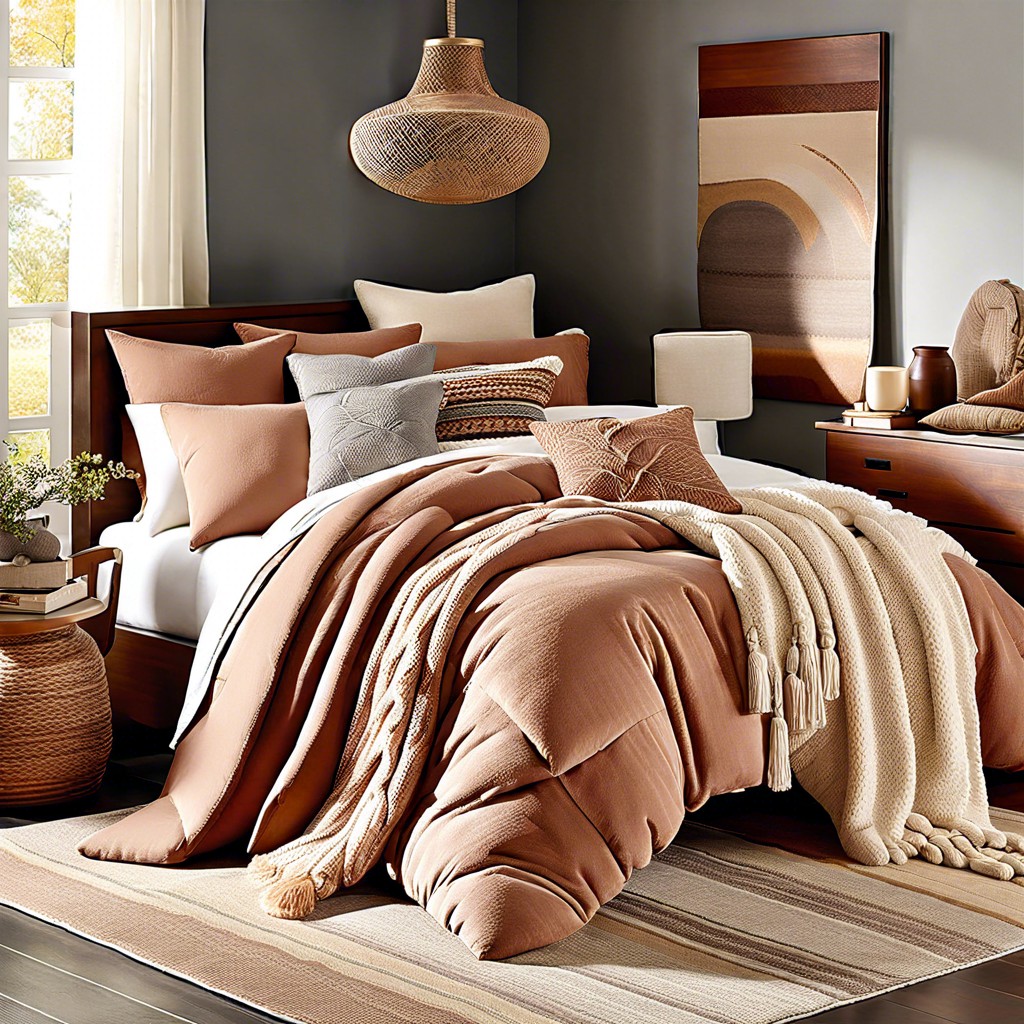Last updated on
Transform your bed into a stylish couch with simple, creative touches to maximize your space and refresh your room’s aesthetic.
Key takeaways:
- Select streamlined, fitted bedding in neutral colors for a couch-like appearance.
- Arrange large Euro pillows for a structured backrest and use accent pillows for a curated look.
- Choose a textured throw blanket that complements the room’s color palette.
- Position the bed against the longest wall and flank it with furniture for a cozy nook effect.
- Incorporate side tables that match the height of the bed for functionality and a seamless look.
Table of Contents
Selecting the Right Bedding

When choosing bedding to transform a bed into a couch-like appearance, focus on fitted and streamlined options. A fitted sheet in a neutral or solid color provides a snug base that mimics the look of a couch upholstery. Consider using a bedspread or a fitted daybed cover that wraps tightly around the edges of the bed, avoiding any loose or flowing fabric which can give away the bed’s true purpose.
Avoid traditional fluffy duvets or comforters as they tend to look too bedroom-centric. Instead, look for quilted patterns or thinner comforters that lie flat, enhancing the structured, sofa-like aesthetic. Aim for durability and ease of maintenance in your selection since the surface will likely endure more sitting than a typical bed.
Materials also play a crucial role. A thicker, woven fabric gives off a sofa vibe more than a silky or sateen finish would. Some materials also mimic the texture of couch materials, such as canvas or microfiber, adding to the authenticity of the transformation.
Using Pillows for Shape and Structure
Strategically arranging pillows can transform a bed’s appearance to more closely resemble a couch. Begin by choosing large, square Euro pillows to create a structured backrest along the wall. These serve as the foundation and visually mimic the solid back of a traditional couch.
Next, layer in standard bed pillows, which provide additional support and comfort for seating. To enhance the couch-like aesthetic, select pillowcases in colors and patterns that coordinate with your room’s decor.
Accent pillows offer both a decorative touch and help to define the seating area. Mix and match sizes and textures for a curated look that invites relaxation. Bolster pillows can be placed on the sides, functioning as armrest supports and further shaping the bed into a couch silhouette.
By focusing on form and firmness, choose pillows that hold their shape well. Memory foam or down alternatives are excellent choices for maintaining structural integrity. The arrangement should invite you to sit as well as lounge, making your bed not only a restful sleeping space but also a comfortable nook for daytime use.
Adding a Throw Blanket for Texture and Color
A well-chosen throw blanket can serve multiple purposes, from offering cozy comfort to acting as a stylish accessory. When draped over the length of the bed, it creates a casual look akin to a couch. Here’s how to enhance the bed’s couch-like appearance:
Consider the fabric of your throw blanket; a chunky knit adds a homely feel, while a smooth, plush fabric can lend a more luxurious touch. Both options contribute to the couch’s inviting quality. A throw with a distinct texture contrasts with the bedding, clearly defining the sitting area.
Color is equally important. A throw that complements the room’s color palette ties the look together. For a bolder statement, opt for a vibrant hue or a striking pattern that stands out against the bedding. This emphasizes the bed’s transformation into a couch.
Arranging the throw is key. Rather than laying it flat, try folding it lengthwise and letting it cascade down the front corner of the bed. Alternatively, for a more lived-in aesthetic, an artful, asymmetrical drape achieves a relaxed vibe that welcomes you to sit and unwind.
Optimizing Bed Position in the Room
Placing the bed against the longest wall usually gives a more sofa-like impression. Ensure it’s accessible from both sides to mimic the openness of a couch. If possible, the bed should sit in a corner, allowing one side to meet the wall for a cozy nook that feels more like a daybed. Positioning the bed perpendicular to the wall gives an authentic look and allows for back pillows to create a sofa backrest illusion.
Avoid isolating the bed in the center of the room as it tends to maintain a traditional bed appearance. Instead, flank the bed with furniture pieces like bookshelves, or side tables; this frames the bed and enhances the couch effect. The furniture also provides functionality for placing lamps, books, and decorations typically found in a living room setting.
Consider the room’s overall flow and try not to obstruct pathways. A smooth transition between the bed and the rest of the space will reinforce its dual purpose without compromising the room’s functionality. Remember, the goal is to blend your bed seamlessly into the living area, making the transformation convincing.
Incorporating a Side Table
A side table adds functionality and lends a couch-like appearance to your bed. Choose a table that matches the height of your bed to create a seamless look. This encourages the use of the surface as you would with a traditional sofa: for placing drinks, books, or a decorative lamp. If space allows, opt for a table on each side to frame the bed and emphasize a symmetrical sofa setup.
For a cohesive design, the style of the side tables should complement the overall aesthetic of the room and the bedding you’ve chosen. Consider tables with drawers or shelves for added storage, similar to what you might find in a living room. Adding table accessories such as coasters, small planters, or framed photos can further enhance the sofa illusion and provide personal touches that make the space welcoming.




